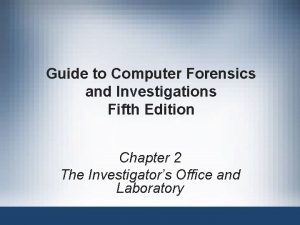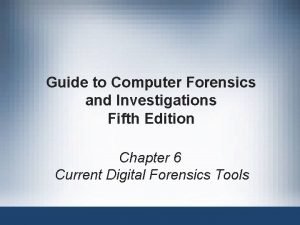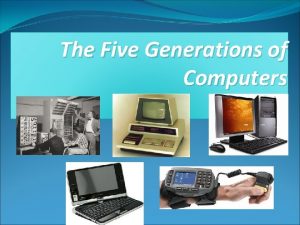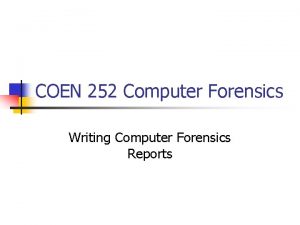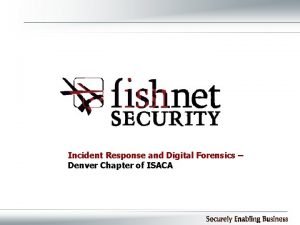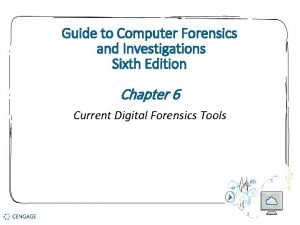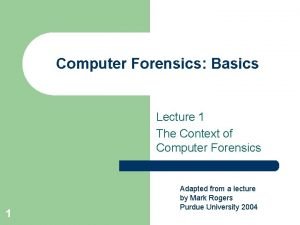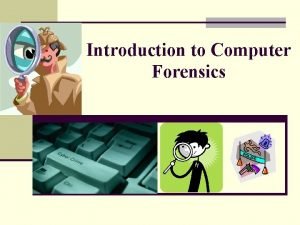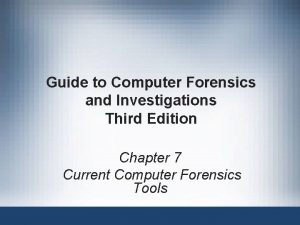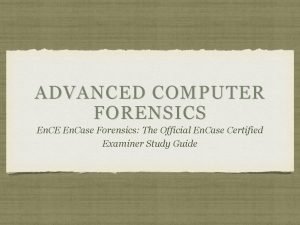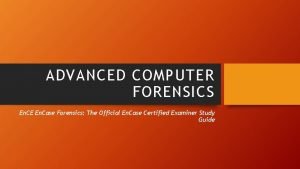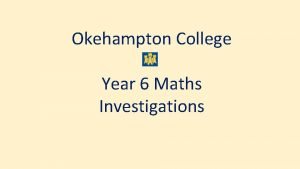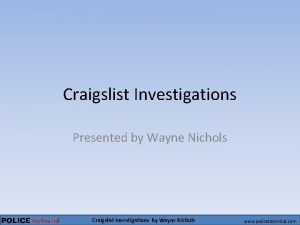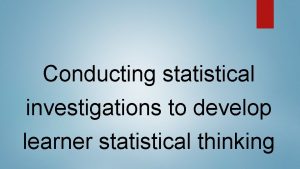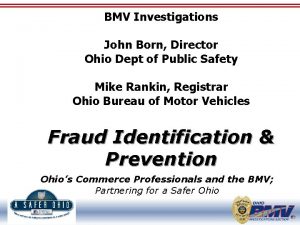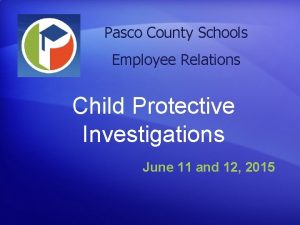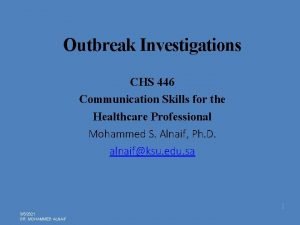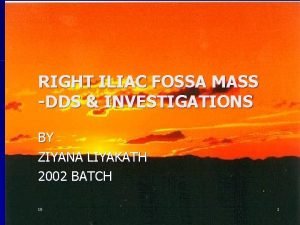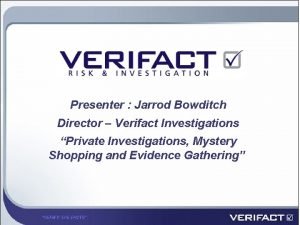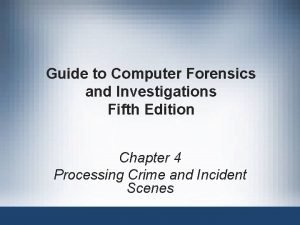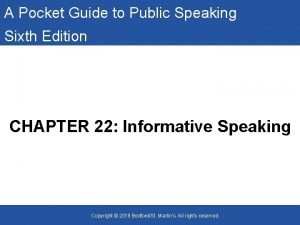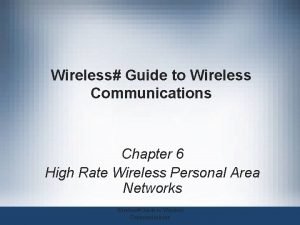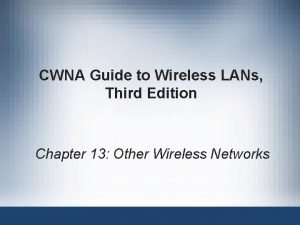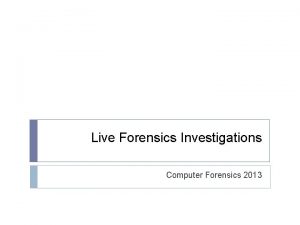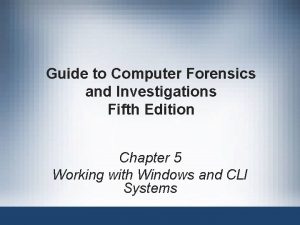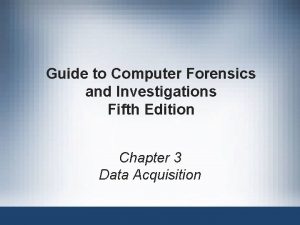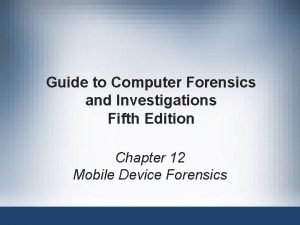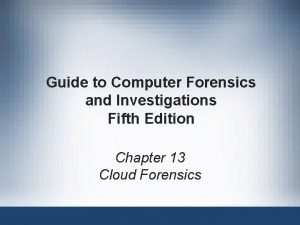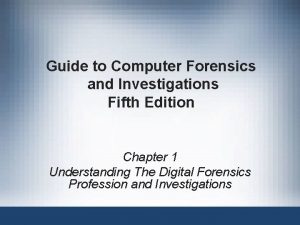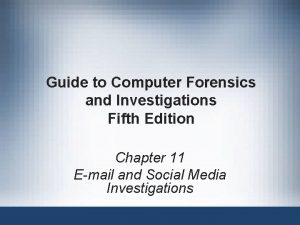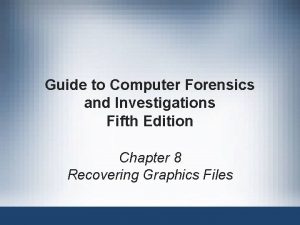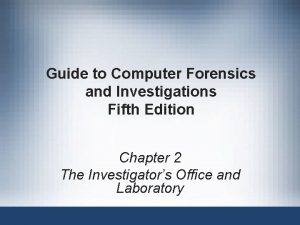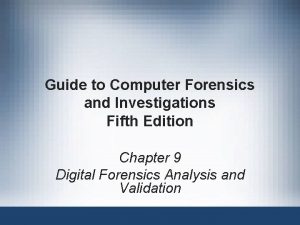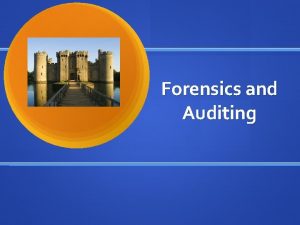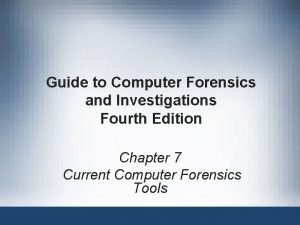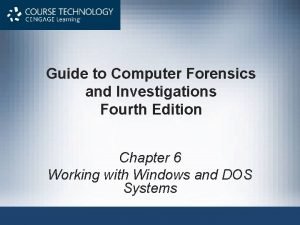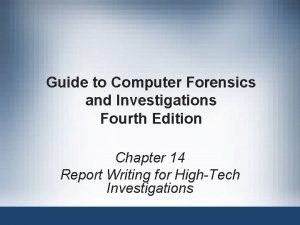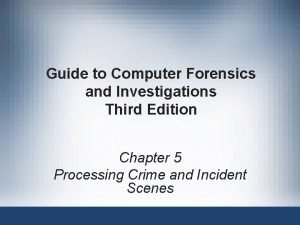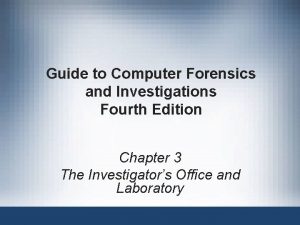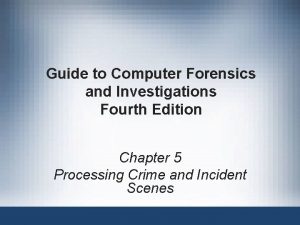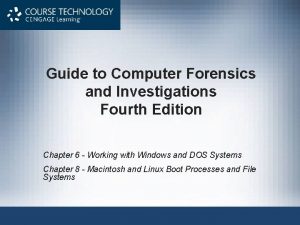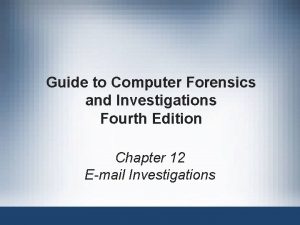Guide to Computer Forensics and Investigations Fifth Edition
















































- Slides: 48

Guide to Computer Forensics and Investigations Fifth Edition Chapter 11 E-mail and Social Media Investigations

Objectives • Explain the role of e-mail in investigations • Describe client and server roles in e-mail • Describe tasks in investigating e-mail crimes and violations • Explain the use of e-mail server logs • Explain how to approach investigating social media communications • Describe some available e-mail forensics tools Guide to Computer Forensics and Investigations, Fifth Edition © Cengage Learning 2015 2

Exploring the Role of E-mail in Investigations • An increase in e-mail scams and fraud attempts with phishing or spoofing – Investigators need to know how to examine and interpret the unique content of e-mail messages • Phishing e-mails contain links to text on a Web page – Attempts to get personal information from reader • Pharming - DNS poisoning takes user to a fake site • A noteworthy e-mail scam was 419, or the Nigerian Scam Guide to Computer Forensics and Investigations, Fifth Edition © Cengage Learning 2015 3

Exploring the Role of E-mail in Investigations • Spoofing e-mail can be used to commit fraud • Investigators can use the Enhanced/Extended Simple Mail Transfer Protocol (ESMTP) number in the message’s header to check for legitimacy of email Guide to Computer Forensics and Investigations, Fifth Edition © Cengage Learning 2015 4

Exploring the Roles of the Client and Server in E-mail • E-mail can be sent and received in two environments – Internet – Intranet (an internal network) • Client/server architecture – Server OS and e-mail software differs from those on the client side • Protected accounts – Require usernames and passwords Guide to Computer Forensics and Investigations, Fifth Edition © Cengage Learning 2015 5

Exploring the Roles of the Client and Server in E-mail Guide to Computer Forensics and Investigations, Fifth Edition © Cengage Learning 2015 6

Exploring the Roles of the Client and Server in E-mail • Name conventions – Corporate: john. smith@somecompany. com – Public: whatever@gmail. com – Everything after @ belongs to the domain name • Tracing corporate e-mails is easier – Because accounts use standard names the administrator establishes • Many companies are migrating their e-mail services to the cloud Guide to Computer Forensics and Investigations, Fifth Edition © Cengage Learning 2015 7

Investigating E-mail Crimes and Violations • Similar to other types of investigations • Goals – – Find who is behind the crime Collect the evidence Present your findings Build a case • Know the applicable privacy laws for your jurisdiction Guide to Computer Forensics and Investigations, Fifth Edition © Cengage Learning 2015 8

Investigating E-mail Crimes and Violations • E-mail crimes depend on the city, state, or country – Example: spam may not be a crime in some states – Always consult with an attorney • Examples of crimes involving e-mails – – – Narcotics trafficking Extortion Sexual harassment and stalking Fraud Child abductions and pornography Terrorism Guide to Computer Forensics and Investigations, Fifth Edition © Cengage Learning 2015 9

Examining E-mail Messages • Access victim’s computer or mobile device to recover the evidence • Using the victim’s e-mail client – Find and copy evidence in the e-mail – Access protected or encrypted material – Print e-mails • Guide victim on the phone – Open and copy e-mail including headers • You may have to recover deleted e-mails Guide to Computer Forensics and Investigations, Fifth Edition © Cengage Learning 2015 10

Examining E-mail Messages • Copying an e-mail message – Before you start an e-mail investigation • You need to copy and print the e-mail involved in the crime or policy violation – You might also want to forward the message as an attachment to another e-mail address • With many GUI e-mail programs, you can copy an e -mail by dragging it to a storage medium – Or by saving it in a different location Guide to Computer Forensics and Investigations, Fifth Edition © Cengage Learning 2015 11

Viewing E-mail Headers • Investigators should learn how to find e-mail headers – GUI clients – Web-based clients • After you open e-mail headers, copy and paste them into a text document – So that you can read them with a text editor • Become familiar with as many e-mail programs as possible – Often more than one e-mail program is installed Guide to Computer Forensics and Investigations, Fifth Edition © Cengage Learning 2015 12

Viewing E-mail Headers • Outlook – Double-click the message and then click File, Properties – Copy headers – Paste them to any text editor – Save the document as Outlook. Header. txt in your work folder Guide to Computer Forensics and Investigations, Fifth Edition © Cengage Learning 2015 13

Viewing E-mail Headers Guide to Computer Forensics and Investigations, Fifth Edition © Cengage Learning 2015 14

Viewing E-mail Headers • AOL – Click the Options link, click E-mail Settings – Click Always show full headers check box (Save settings) – Click Back to E-mail • Yahoo – Click Inbox to view a list of messages – Above the message window, click More and click View Full Header – Copy and paste headers to a text file Guide to Computer Forensics and Investigations, Fifth Edition © Cengage Learning 2015 15

Viewing E-mail Headers Guide to Computer Forensics and Investigations, Fifth Edition © Cengage Learning 2015 16

Examining E-mail Headers • Headers contain useful information – The mail piece of information you’re looking for is the originating e-mail’s IP address – Date and time the message was sent – Filenames of any attachments – Unique message number (if supplied) Guide to Computer Forensics and Investigations, Fifth Edition © Cengage Learning 2015 17

Examining E-mail Headers Guide to Computer Forensics and Investigations, Fifth Edition © Cengage Learning 2015 18

Examining Additional E-mail Files • E-mail messages are saved on the client side or left at the server • Microsoft Outlook uses. pst and. ost files • Most e-mail programs also include an electronic address book, calendar, task list, and memos • In Web-based e-mail – Messages are displayed and saved as Web pages in the browser’s cache folders – Many Web-based e-mail providers also offer instant messaging (IM) services Guide to Computer Forensics and Investigations, Fifth Edition © Cengage Learning 2015 19

Tracing an E-mail Message • Determining message origin is referred to as “tracing” • Contact the administrator responsible for the sending server • Use a registry site to find point of contact: – www. arin. net – www. internic. com – www. google. com • Verify your findings by checking network e-mail logs against e-mail addresses Guide to Computer Forensics and Investigations, Fifth Edition © Cengage Learning 2015 20

Using Network E-mail Logs • Router logs – Record all incoming and outgoing traffic – Have rules to allow or disallow traffic – You can resolve the path a transmitted e-mail has taken • Firewall logs – Filter e-mail traffic – Verify whether the e-mail passed through • You can use any text editor or specialized tools Guide to Computer Forensics and Investigations, Fifth Edition © Cengage Learning 2015 21

Using Network E-mail Logs Guide to Computer Forensics and Investigations, Fifth Edition © Cengage Learning 2015 22

Understanding E-mail Servers • An e-mail server is loaded with software that uses e -mail protocols for its services – And maintains logs you can examine and use in your investigation • E-mail storage – Database – Flat file system • Logs – Some servers are set up to log e-mail transactions by default; others have to be configured to do so Guide to Computer Forensics and Investigations, Fifth Edition © Cengage Learning 2015 23

Understanding E-mail Servers • E-mail logs generally identify the following: – – – E-mail messages an account received Sending IP address Receiving and reading date and time E-mail content System-specific information • Contact suspect’s network e-mail administrator as soon as possible • Servers can recover deleted e-mails – Similar to deletion of files on a hard drive Guide to Computer Forensics and Investigations, Fifth Edition © Cengage Learning 2015 24

Examining UNIX E-mail Server Logs • Common UNIX e-mail servers: Postfix and Sendmail • /etc/sendmail. cf – Configuration file for Sendmail • /etc/syslog. conf – Specifies how and which events Sendmail logs • Postfix has two configuration files – master. cf and main. cf (found in /etc/postfix) Guide to Computer Forensics and Investigations, Fifth Edition © Cengage Learning 2015 25

Examining UNIX E-mail Server Logs • /var/log/maillog – Records SMTP, POP 3, and IMAP 4 communications • Contains an IP address and time stamp that you can compare with the e-mail the victim received • Default location for storing log files: – /var/log – An administrator can change the log location – Use the find or locate command to find them • Check UNIX man pages for more information Guide to Computer Forensics and Investigations, Fifth Edition © Cengage Learning 2015 26

Examining Microsoft E-mail Server Logs • Microsoft Exchange Server (Exchange) – Uses a database – Based on Microsoft Extensible Storage Engine (ESE) • Most useful files in an investigation: –. edb database files, checkpoint files, and temporary files • Information Store files – Database files *. edb • Responsible for MAPI information Guide to Computer Forensics and Investigations, Fifth Edition © Cengage Learning 2015 27

Examining Microsoft E-mail Server Logs • Transaction logs – Keep track of changes to its data • Checkpoints – Marks the last point at which the database was written to disk • Temporary files – Created to prevent loss when the server is busy converting binary data to readable text Guide to Computer Forensics and Investigations, Fifth Edition © Cengage Learning 2015 28

Examining Microsoft E-mail Server Logs • To retrieve log files created by Exchange – Use the Windows Power. Shell cmdlet Get. Transaction. Log. Stats. ps 1 -Gather • Tracking. log – An Exchange server log that tracks messages • Another log used for investigating the Exchange environment is the troubleshooting log – Use Windows Event Viewer to read the log Guide to Computer Forensics and Investigations, Fifth Edition © Cengage Learning 2015 29

Examining Microsoft E-mail Server Logs Guide to Computer Forensics and Investigations, Fifth Edition © Cengage Learning 2015 30

Using Specialized E-mail Forensics Tools • Tools include: – – – – – Data. Numen for Outlook and Outlook Express FINALe. MAIL for Outlook Express and Eudora Sawmill for Novell Group. Wise DBXtract for Outlook Express Fookes Aid 4 Mail and Mail. Bag Assistant Paraben E-Mail Examiner Access. Data FTK for Outlook and Outlook Express Ontrack Easy Recovery Email. Repair R-Tools R-Mail Office. Recovery’s Mail. Recovery Guide to Computer Forensics and Investigations, Fifth Edition © Cengage Learning 2015 31

Using Specialized E-mail Forensics Tools • Tools allow you to find: – – E-mail database files Personal e-mail files Offline storage files Log files • Advantage of using data recovery tools – You don’t need to know how e-mail servers and clients work to extract data from them Guide to Computer Forensics and Investigations, Fifth Edition © Cengage Learning 2015 32

Using Specialized E-mail Forensics Tools • After you compare e-mail logs with messages, you should verify the: – Email account, message ID, IP address, date and time stamp to determine whethere’s enough evidence for a warrant • With some tools – You can scan e-mail database files on a suspect’s Windows computer, locate any e-mails the suspect has deleted and restore them to their original state Guide to Computer Forensics and Investigations, Fifth Edition © Cengage Learning 2015 33

Using OSForensics to Recover E-mail • OSForensics – Indexes data on a disk image or an entire drive for faster data retrieval – Filters or finds files specific to e-mail clients and servers • Follow the steps in the activity on page 439 to learn how to use OSForensics to recover e-mails Guide to Computer Forensics and Investigations, Fifth Edition © Cengage Learning 2015 34

Using OSForensics to Recover E-mail Guide to Computer Forensics and Investigations, Fifth Edition © Cengage Learning 2015 35

Using a Hex Editor to Carve E-mail Messages • Very few vendors have products for analyzing email in systems other than Microsoft • mbox format – Stores e-mails in flat plaintext files • Multipurpose Internet Mail Extensions (MIME) format – Used by vendor-unique e-mail file systems, such as Microsoft. pst or. ost • Example: carve e-mail messages from Evolution Guide to Computer Forensics and Investigations, Fifth Edition © Cengage Learning 2015 36

Using a Hex Editor to Carve E-mail Messages Guide to Computer Forensics and Investigations, Fifth Edition © Cengage Learning 2015 37

Using a Hex Editor to Carve E-mail Messages Guide to Computer Forensics and Investigations, Fifth Edition © Cengage Learning 2015 38

Using a Hex Editor to Carve E-mail Messages Guide to Computer Forensics and Investigations, Fifth Edition © Cengage Learning 2015 39

Recovering Outlook Files • A forensics examiner recovering e-mail messages from Outlook – May need to reconstruct. pst files and messages • With many advanced forensics tools – Deleted. pst files can be partially or completely recovered • Scanpst. exe recovery tool – Comes with Microsoft Office – Can repair. ost files as well as. pst files Guide to Computer Forensics and Investigations, Fifth Edition © Cengage Learning 2015 40

Recovering Outlook Files • Guidance Software uses the Sys. Tools plug-in – For Outlook e-mail through version 2013 – Systools extracts. pst files from En. Case Forensic for analysis • Data. Numen Outlook Repair – One of the better e-mail recovery tools – Can recovery files from VMware and Virtual PC Guide to Computer Forensics and Investigations, Fifth Edition © Cengage Learning 2015 41

E-mail Case Studies • In the Enron Case, more than 10, 00 emails contained the following personal information: – 60 containing credit card numbers – 572 containing thousands of Social Security or other identity numbers – 292 containing birth dates – 532 containing information of a highly personal nature • Such as medical or legal matters Guide to Computer Forensics and Investigations, Fifth Edition © Cengage Learning 2015 42

Applying Digital Forensics to Social Media • Online social networks (OSNs) are used to conduct business, brag about criminal activities, raise money, and have class discussions • Social media can contain: – Evidence of cyberbullying and witness tampering – A company’s position on an issue – Whether intellectual property rights have been violated – Who posted information and when Guide to Computer Forensics and Investigations, Fifth Edition © Cengage Learning 2015 43

Applying Digital Forensics to Social Media • Social media can often substantiate a party’s claims • OSNs involve multiple jurisdictions that might even cross national boundaries • A warrant or subpoena is needed to access social media servers • In cases involving imminent danger, law enforcement can file for emergency requests Guide to Computer Forensics and Investigations, Fifth Edition © Cengage Learning 2015 44

Forensics Tools for Social Media Investigations • Software for social media forensics is being developed – Not many tools are available now • There are questions about how the information these tools gather can be used in court or in arbitration • Using social media forensics software might also require getting the permission of the people whose information is being examined Guide to Computer Forensics and Investigations, Fifth Edition © Cengage Learning 2015 45

Summary • E-mail fraudsters use phishing, pharming, and spoofing scam techniques • In both Internet and intranet e-mail environments, e -mail messages are distributed from one central server to connected client computers • E-mail investigations are similar to other kinds of investigations • Access victim’s computer to recover evidence – Copy and print the e-mail message involved in the crime or policy violation Guide to Computer Forensics and Investigations, Fifth Edition © Cengage Learning 2015 46

Summary • Use the e-mail program that created the message to find the e-mail header, which provides supporting evidence and can help you track the suspect to the originating location • Investigating e-mail abuse – Be familiar with e-mail servers and clients’ operations • For many e-mail investigations you can rely on email message files, headers, and server log files Guide to Computer Forensics and Investigations, Fifth Edition © Cengage Learning 2015 47

Summary • For e-mail applications that use the mbox format, a hexadecimal editor can be used to carve messages manually • Social media, or OSNs can provide evidence in criminal and civil cases – Software for collecting OSN information is being developed • Social media forensics tools are still very new – Can be used to find out which people users have been in touch with, when, and how often Guide to Computer Forensics and Investigations, Fifth Edition © Cengage Learning 2015 48
 Guide to computer forensics and investigations
Guide to computer forensics and investigations Building a forensic workstation
Building a forensic workstation Guide to computer forensics and investigations
Guide to computer forensics and investigations Principles of marketing fifth european edition
Principles of marketing fifth european edition Lazarus cognitive appraisal theory
Lazarus cognitive appraisal theory Fundamentals of corporate finance fifth edition
Fundamentals of corporate finance fifth edition Fifth edition chemistry a molecular approach
Fifth edition chemistry a molecular approach Segregat
Segregat Molecular biology of the cell fifth edition
Molecular biology of the cell fifth edition Human anatomy fifth edition
Human anatomy fifth edition Human anatomy fifth edition
Human anatomy fifth edition What are the five generations of computers
What are the five generations of computers Forensic science fundamentals and investigations chapter 6
Forensic science fundamentals and investigations chapter 6 Digital forensic report template
Digital forensic report template Digital forensics denver
Digital forensics denver Computer forensics workstation
Computer forensics workstation Objectives of computer forensics
Objectives of computer forensics Introduction to computer forensics
Introduction to computer forensics Computer forensics tool testing
Computer forensics tool testing Tasks performed by computer forensics tools
Tasks performed by computer forensics tools Anum sattar
Anum sattar Advanced computer forensics
Advanced computer forensics Advanced computer forensics
Advanced computer forensics Using mis 10th edition
Using mis 10th edition Using mis (10th edition)
Using mis (10th edition) Why aren t descriptive investigations repeatable
Why aren t descriptive investigations repeatable Nrich maths investigations
Nrich maths investigations Craigslist investigations
Craigslist investigations Unit 3 statistical studies answers
Unit 3 statistical studies answers Types of statistical investigation
Types of statistical investigation Bmv hours heatherdowns
Bmv hours heatherdowns Scientific investigations
Scientific investigations Pasco child protective services
Pasco child protective services Chs investigations
Chs investigations Appendiculolith
Appendiculolith Verifact investigations
Verifact investigations 3 weeks pregnant ultrasound
3 weeks pregnant ultrasound Investigations
Investigations Chs investigations
Chs investigations Florida real estate broker's guide
Florida real estate broker's guide Florida real estate broker's guide 6th edition
Florida real estate broker's guide 6th edition A pocket guide to public speaking 6th edition
A pocket guide to public speaking 6th edition Guide to wireless communications 4th edition
Guide to wireless communications 4th edition Prehospital emergency care 11th edition
Prehospital emergency care 11th edition Florida real estate broker's guide 6th edition
Florida real estate broker's guide 6th edition Florida real estate broker's guide 6th edition
Florida real estate broker's guide 6th edition Cwna guide to wireless lans 3rd edition
Cwna guide to wireless lans 3rd edition Florida real estate broker's guide
Florida real estate broker's guide A pocket guide to public speaking 6th edition
A pocket guide to public speaking 6th edition

